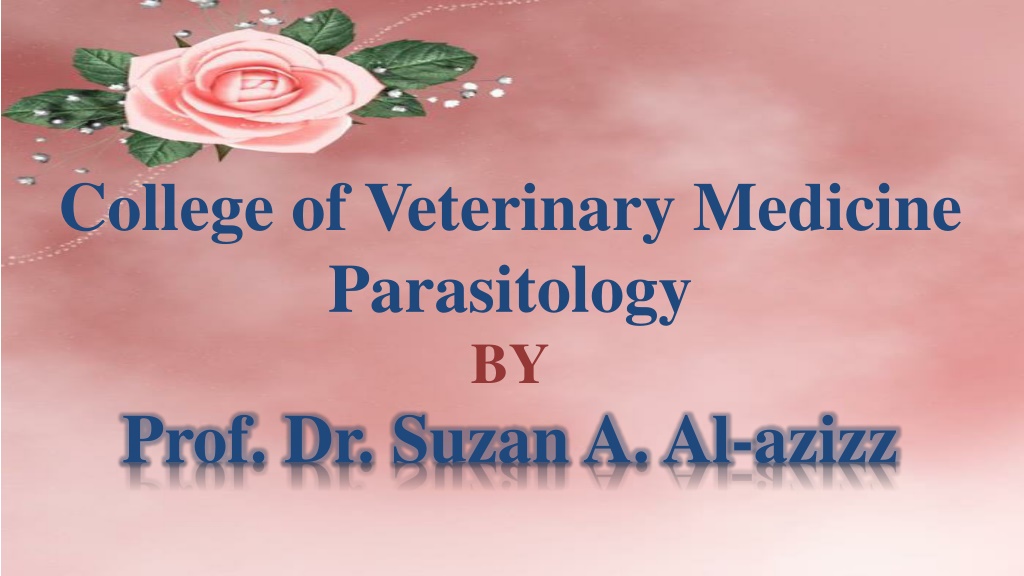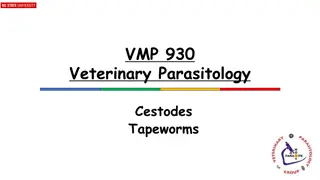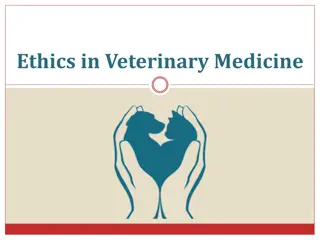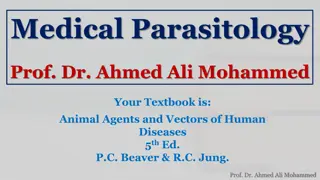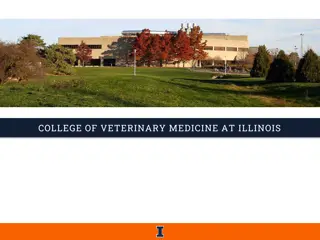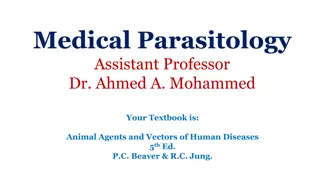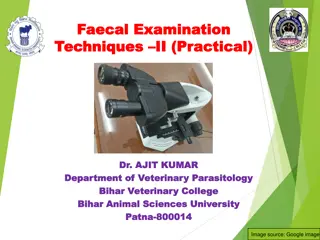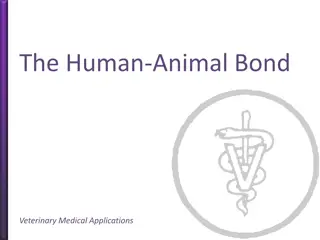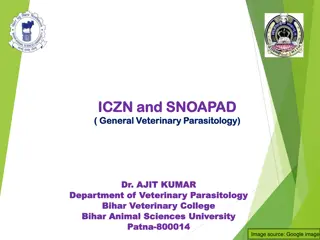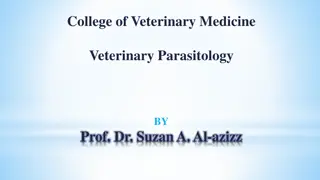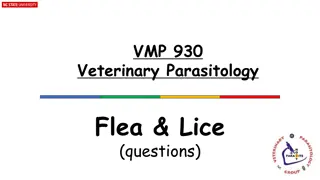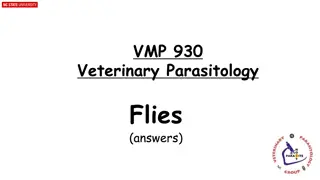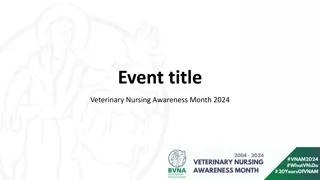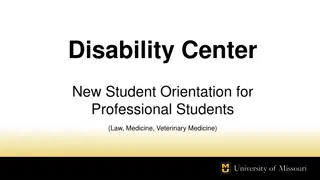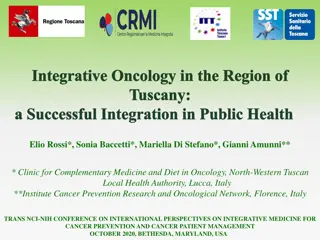Understanding Parasitology in Veterinary Medicine by Prof. Dr. Suzan A. Al-azizz
Parasitology is a vital study of parasites and their hosts, encompassing various disciplines like cell biology, bioinformatics, genetics, and ecology. This field emphasizes the binomial system of species naming pioneered by Linnaeus. The essence of human scientific naming is exemplified by Homo sapiens. The taxonomy of pathogens is outlined, and medical parasitology covers protozoa, helminthes, and disease-causing arthropods. Parasitology involves symbiosis, where organisms coexist closely with another species, and it explores diverse types of symbiotic relationships.
Download Presentation

Please find below an Image/Link to download the presentation.
The content on the website is provided AS IS for your information and personal use only. It may not be sold, licensed, or shared on other websites without obtaining consent from the author. Download presentation by click this link. If you encounter any issues during the download, it is possible that the publisher has removed the file from their server.
E N D
Presentation Transcript
College of Veterinary Medicine Parasitology BY Prof. Dr. Suzan A. Al-azizz
A SPECIES IS BINOMIAL Parasitology is the study of parasites, their hosts, and the relationship between them. As a biological discipline, the scope of Parasitology is not determined by the organism or environment in question, but by their way of life, so this means it forms a synthesis of other disciplines, and draws on techniques from fields such as cell biology, bioinformatics, biochemistry, molecular biology, immunology, genetics, evolution and ecology.
And before the beginning the fascinating topic of Parasitology, there tend to be one common deficiency that needs immediate remedy. Namely, the basic Linnaeus concept or rule that states that a species is binomial. This is a universal in zoology, botany, Parasitology, and bacteriology, but for some reason many students have failed to grasp this concept. The Swedish scientist Carolus von Linnaeus (1707-1778) developed the binomial system of nomenclature that is still in use today. As an example, let's use the species Homo sapiens ("humans" to you molecular biologists). Homo is the genus, sapiens is the trivial name (nomentriviale or specific epithet), and together they make up the species. The epithet sapiens is NOT the species, although some very basic texts erroneously say it is. Remember... a species is binomial ("two names").
SO, ANSWER THIS QUESTION GIVE THE SCIENTIFIC NAME OF HUMAN? IS THIS DIFECULT OR WHAT??? GIVE ME YOUR ANSWER IN THREE SECONDS
The taxonomically of pathogens classify according to the sachem below:
INTRODUCTION TO THE PARASITOLOGY Medical parasitology traditionally has included the study of three major groups of animals: parasitic protozoa, parasitic helminthes (worms), and those arthropods that directly cause disease or act as vectors of various pathogens. The relationship between organisms as in the sachem below:
Parasitology is a type of SYMBIOSIS that living together in the plant, animal, or protest, which is intimately associated with another organism of a different species and each member is termed a SYMBIONT. There are various type of symbiosis: PHORESIS is a traveling together or to carry, that is mean a smaller organism is termed a PHORONT that is carried mechanically by a HOST for instance, bacteria, fungus, cysts, or eggs on insect legs or even passively within an arthropod gut. COMMENSALISM means when one symbiont is named a COMMENSAL, benefits and the other animal is neither helped nor harmed and true commensalism is difficult to find, and may not even actually exist. Close inspections usually reveal either a mutualistic or parasitic association. Perhaps Entamoeba gingivalis in mouth to some degree; some pilot fish and remoras associated with sharks MUTUALISM means each member is named MUTUALIST, depends upon the other and obligatory or facultative in nature for instance, flagellates produce cellulose in gut of termites, ciliates in ruminants, algae and fungus forming a lichen; crocodiles and Egyptian teeth cleaning plovers.
PREDATION means where one member is named a PREDATOR, benefits and a smaller organism is called a PREY that is harmed and usually eaten. This association is not usually considered a type of symbiosis, but it technically falls under the definition. Examples include coyotes and rabbits, cats and mice. PARASITISM means where one member is named a PARASITE, lives in or on another organism that is called a HOST. However, PARASITOLOGY is the study of the relationship between a parasite and its host. This method of existence is the single most successful way of making a living, and it has been estimated that no less than 80% of all species of organisms are parasites. Parasitic relationships may be temporary, facultative, or obligatory.
ANSWER THIS QUESTION GIVE THE NAME OF YOUR RELATIONSHIPE WITH YOUR FRIEND IN TWO SECONDS
The Basic types of parasitism and terminology ECTOPARASITE: lives on surface of the host, appropriate terminology includes the terms "infected" and "infested" [i.e. ticks, lice, fleas]. ENDOPARASITE: lives within the host, appropriate terminology is "infected;" infested is inappropriate terminology [i.e. roundworms in gut, tapeworms in gut]. HYPERPARASITE: parasite within a parasite [i.e. malaria in mosquitoes; tapeworm larvae in fleas]. VECTORS: transmits parasites from host to host, and this is divided into: BIOLOGICAL VECTOR: essential in life-cycle of parasite. MECHANICAL VECTOR: unessential in life-cycle of parasite phonetic.
Class of Parasites Temporary Parasite: Visits it's host for a short period. Permanent Parasite: Leads a parasitic life throughout the whole period of its life. Facultative Parasite: Leaves a parasitic life when opportunity arise. Obligatory Parasite: Cannot exist without a parasitic life. Occasional or Accidental Parasite: Attacks an unusual host. Wandering or Aberrant Parasite: Happens to reach a place where it can't live.
- Types of Hosts: Definitive or Final Host : Host in which parasite reaches sexual maturity and reproduces. Intermediate Host: Some development in host, but does not reach sexual maturity, often asexual stages. Paratenic or Transport Host: No parasite development; but parasite continues to live and is infective to next host, for instance and pseudophyllidean tapeworm larvae in fish. Reservoir Host: Non-human animals that serve as sources of infection to humans.
Modes of the parasite infection dynamic and transmission Various ways were identified as a mode of the parasite infection and an etiological agent can pass from a host to another. The transmission can be taken placed either direct or indirect 1-The direct transmission: the parasite transmits from animal to a person through direct contact such as touching with contaminated hands. Echinococcus eggs can be transmitted directly from a companion dog to humans or children play on the ground the dusts may be contaminated with the eggs of live parasite. 2-Indirect transmission: this type of transmission occurs indirectly through a mediate object such as airborne, waterborne, vegetables and grass contamination dust, vector, and fomites). For example, Leishmania spp is transmitted to humans by phlebotomine sand fly bites. Another example Trypanosoma is transmitted to humans by tsetse fly (Glossina genus).A variety of animal hosts can be act as a reservoir for parasites infection and the transmission is substantially occurred by
Vector hosts area living organism involves in the life cycle of the parasite. Most of these vectors are bloodsucking insects talking a blood meal from animal or human and transferred to another host. A typical example of vector borne diseases including Schistosomiasis, human African Trypanosomiasis, Leishmaniasis, and Onchocerciasis. Reservoir hosts are humans, animals, crustaceans, and inanimate organic (faeces or food) where parasites are able to live, grow and multiply under a convenient environment. For example, Diphylobothirum latum (fish or broad tapeworm), the Infections are acquired by eating raw or undercooked fish in some communities. Carrier hosts is referred to the host harboring a pathogen without showing clinical symptoms or being less severally ill. Thus, animals serve as a source of infection transmission parasites from animal to another or to humans while remains in apparently diseased sometimes called asymptomatic carriers example, nematodes parasites.
Scheme of Complex Life Cycle Two or more host species and parasite exploits food chain relationships of hosts - increases chances of locating hosts and reduces chances of super-infecting host.
